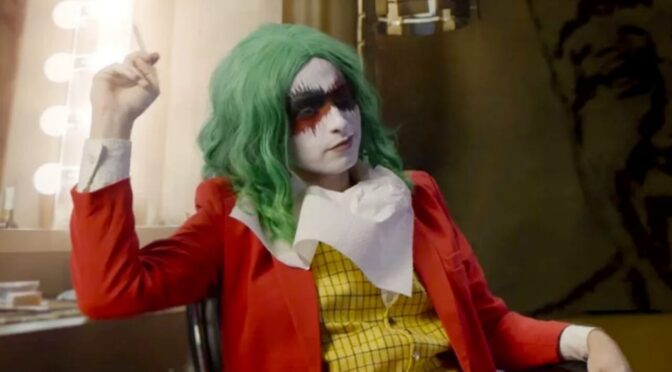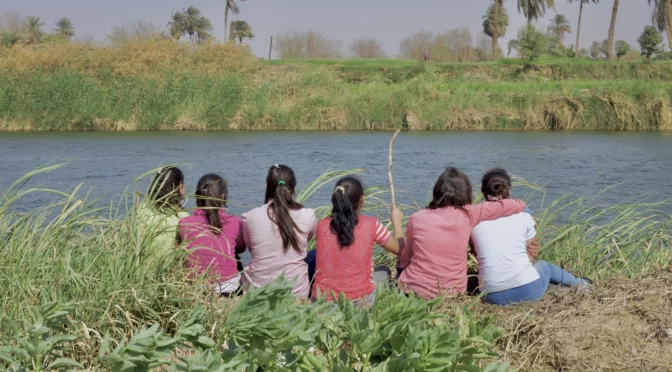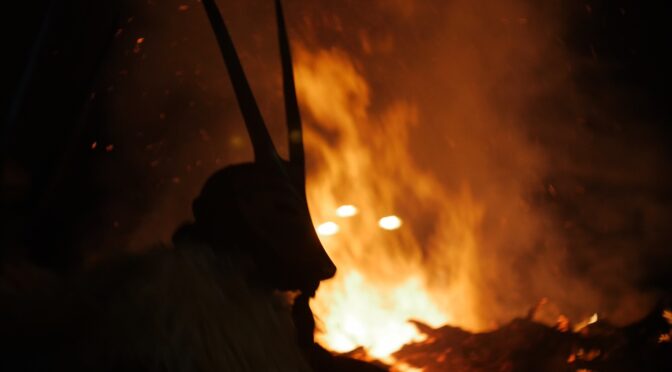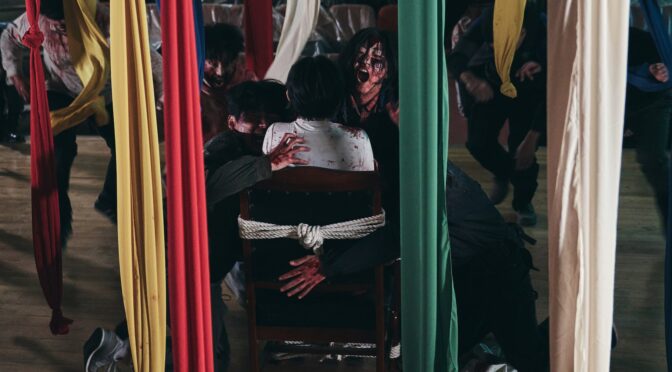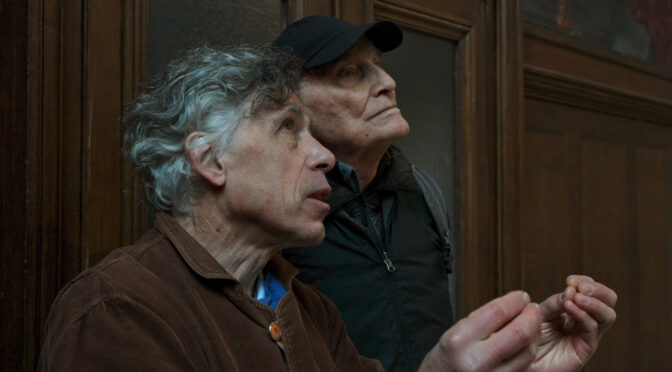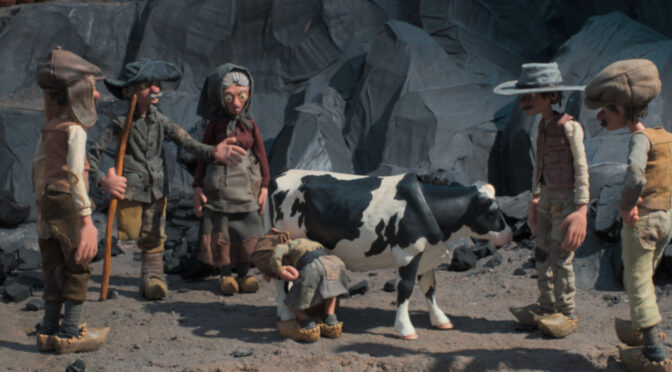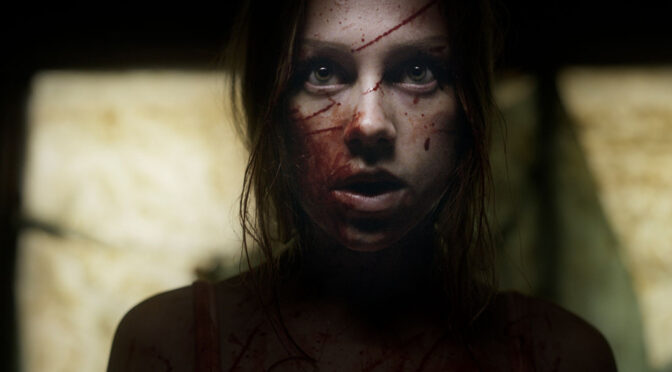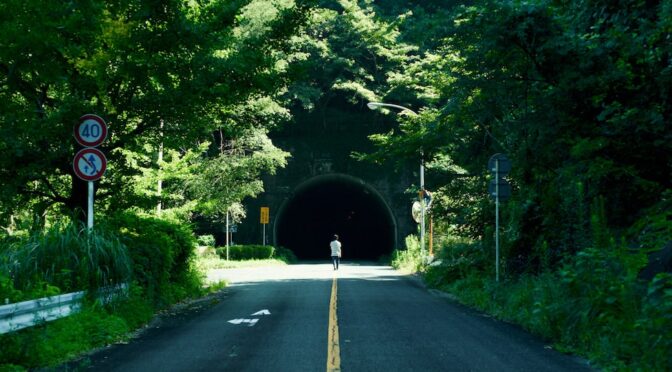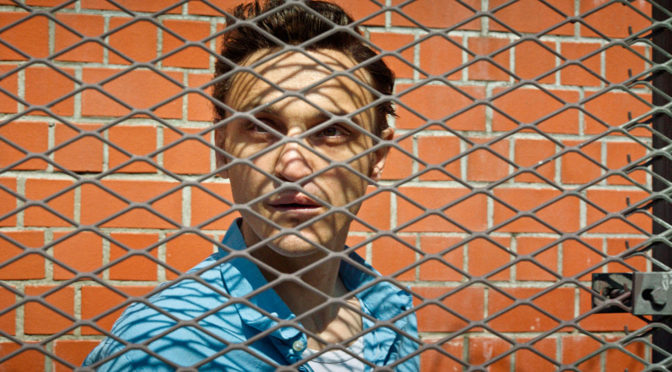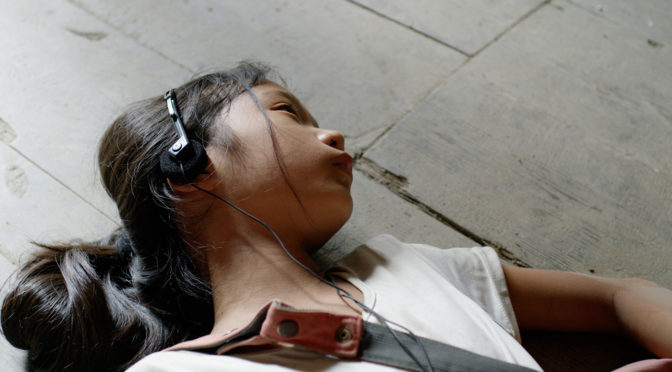Una storia (o un sogno) che non ha mai fine, perché non esiste limite al gioco della fantasia: una dimensione spirituale che ammette ogni possibilità, persino quella di riscrivere il proprio destino e vivere una fantastica avventura. Ma anche nel più bel sogno si insidiano storture nascoste e glitch. Con Mind Game, lungometraggio di animazione sperimentale, Masaaki Yuasa offre allo spettatore uno spettacolare viaggio verso infinte possibilità. Un futuro, astratto e metaforico a livello tematico, ma concreto sul piano della sperimentazione del linguaggio cinematografico. Tutto ciò reso con un’estetica animata selvaggia e disomogenea, punto di forza attrattivo del film.
Continua la lettura di “MIND GAME” DI MASAAKI YUASAArchivi tag: film
“THE PEOPLE’S JOKER” DI VERA DREW
Come realizzare un’opera di formazione e autoconsapevolezza che guardi al proprio passato, senza però scomodare Lacan o Freud? La risposta la offre la regista Vera Drew, unendo nostalgia e passione kitsch per l’universo DC Comics in tutte le sue declinazioni. Questi elementi danno vita a The People’s Joker: un coming of age queer e metariflessivo che decostruisce le consuetudinarie argomentazioni sulle tematiche di gender. Al tempo stesso, un racconto autobiografico che si sposta tra passato e presente in maniera ironica e smaccatamente personale.
Continua la lettura di “THE PEOPLE’S JOKER” DI VERA DREW“THE BRINK OF DREAMS” BY NADA RIYADH E AYMAN EL AMIR
Article by Lisa Cortopassi
Translation by Aurora Monteleone
In the opening image of The Brink of Dreams, we can see six girls running through a field. As in the case of the scene of three children walking in the Icelandic countryside from which Chris Marker’s Sans Soleil (1983) takes its cue, this moment also evokes the sensation of witnessing a dream, a vision of hope.
Continua la lettura di “THE BRINK OF DREAMS” BY NADA RIYADH E AYMAN EL AMIR“THE BRINK OF DREAMS” DI NADA RIYADH E AYMAN EL AMIR
Nell’immagine che apre The Brink of Dreams vediamo sei ragazze che corrono in un campo. Come nel caso della scena dei tre bambini che passeggiano nella campagna islandese da cui prende le mosse Sans soleil di Chris Marker (1983), anche qui si ha la sensazione di assistere a un sogno, a una visione di speranza.
Continua la lettura di “THE BRINK OF DREAMS” DI NADA RIYADH E AYMAN EL AMIR“IMMÉMORIAL, CHANTS DE LA GRANDE NUIT” BY BÉATRICE KORDON
Article by Lisa Cortopassi
Translation by Martina Bigi
Darkness, cold. A metallic melody and an off-screen voice introduce the spatial and thematic coordinates of Immémorial, Chants de la Grande Nuit. Legend has it that, in a primordial moment, the Gods tore the Night to reveal the “world of things.” This is how form, language, and day were created. Using this myth as a framework, Béatrice Kordon investigates on the “immemorial” time: a time that is both past and future, a time that leaves no trace and waves between death and birth, darkness and light.
Continua la lettura di “IMMÉMORIAL, CHANTS DE LA GRANDE NUIT” BY BÉATRICE KORDON“IMMÉMORIAL, CHANTS DE LA GRANDE NUIT” DI BÉATRICE KORDON
Buio, freddo. Una melodia metallica e una voce fuori campo introducono le coordinate atmosferiche e tematiche di Immémorial, Chants de la Grande Nuit. Si racconta di un momento primigenio in cui gli Dei avrebbero squarciato la Notte per far emergere il «mondo delle cose». Così sarebbero nate la forma, la parola e il giorno. Servendosi del mito, Béatrice Kordon conduce un’indagine sul tempo “immemorabile”: un tempo che è tanto passato quanto futuro, che non ha traccia e che è in bilico tra la morte e la nascita, tra il buio e la luce.
Continua la lettura di “IMMÉMORIAL, CHANTS DE LA GRANDE NUIT” DI BÉATRICE KORDON“THE SIN” BY HAN DONG-SEOK
Article by Emidio Sciamanna
Translation by Francesca Borgheresi
Lurking in the shadows of a social pessimism and often embodied by the human values of science and justice, the search for rationality takes the ruthless and tragic shape of a great evil, which is a demon that feeds itself with collective discrimination and mutual hate. The second full-length film by Han Dong-seok, The Sin, presented in the category “Crazies” of the 41st edition of Torino Film Festival, suggests a crazy concept of the original sin, where fear and the obsessive desire of revenge insinuate in the mechanic physicality of multiple moving bodies.
Continua la lettura di “THE SIN” BY HAN DONG-SEOK“THE SIN” DI HAN DONG-SEOK
Celata nell’ombra del pessimismo sociale, la ricerca della razionalità, spesso incarnata dai valori umani della scienza e della giustizia, prende le forme spietate e drammatiche di un male superiore, un demone che si alimenta della discriminazione collettiva e dell’odio reciproco. È in questo modo che il secondo lungometraggio di Han Dong-seok, The Sin, presentato nella sezione Crazies del 41^ Torino Film Festival, propone una folle visione del peccato originale, in cui il sentimento di paura e l’ossessivo desiderio di vendetta si insinuano nella fisicità meccanica di molteplici corpi in movimento.
Continua la lettura di “THE SIN” DI HAN DONG-SEOK“RICARDO ET LA PEINTURE” BY BARBET SCHROEDER
Article by Emidio Sciamanna
Translation by Chiara Rotondo
An elderly painter climbs the steep cliff face of Brittany’s coastline, wearing worn-out clothes and holding his palette, easel and brushes in hand. Upon reaching a secluded grotto, he is free to express his imagination against the stunning coastal backdrop. This is the opening scene of Barbet Schroeder’s latest documentary, Ricardo et la peinture (“Ricardo and painting”), which premiered Out of Competition at the 41st Turin Film Festival.
Continua la lettura di “RICARDO ET LA PEINTURE” BY BARBET SCHROEDER“RICARDO ET LA PEINTURE” DI BARBET SCHROEDER
Abiti consumati, pennelli in mano, tavolozza e cavalletto sulle spalle: nel cuore della Bretagna, sullo sfondo di un suggestivo paesaggio costiero, un anziano pittore si inerpica faticosamente lungo la ripida parete rocciosa di un litorale, fino a raggiungere una piccola grotta nascosta, dove può dare libero sfogo alla sua fantasia. È l’inizio del nuovo documentario di Barbet Schroeder, Ricardo et la peinture, presentato Fuori Concorso alla 41^ edizione del Torino Film Festival.
Continua la lettura di “RICARDO ET LA PEINTURE” DI BARBET SCHROEDER“MANODOPERA – INTERDIT AUX CHIENS ET AUX ITALIENS” BY ALAIN UGHETTO
Article by: Emidio Sciamanna
Translated by: Maria Bellantoni
Memories of a distant past that gradually fades in time often remain linked to an ideal world reworked by our minds to preserve emotions, sensations, fleeting instants of our existence in which we have, even for an instant, savoured flashes of true happiness. Manodopera recounts the world evoked by the sweet and nostalgic words of a grandmother, restoring the memory of a bygone era, made up of sacrifices and carefreeness, suffering and love.
The location, recreated in stop-motion, is a small mountain village at the foot of Monviso. It is called Borgata Ughettera and recalls the director Alain Ughetto’s Piedmontese origins. The film comes to life through the words of Cesira, his grandmother, who thinks back to her youth towards the end of the 19th century. Starting from some fundamental events, she thus gives rise to a reality suspended in time that is emphasised by the fragile malleability of the plasticine with which the characters are made of.
Between cardboard houses and bizarre broccoli trees, the objects somehow represent an indispensable aspect of the story; tangible elements whose purpose is to bring the sweetness of a memory closer to the purity of nature. The simplicity of the poor peasant world, the meeting with her future husband Luigi, the difficult periods of war and the need to emigrate to France in order to work and survive: these are the episodes that characterise Cesira’s past and that she describes to her nephew, in a surreal and poetic exchange between the animated universe and the real presence of the director on stage.
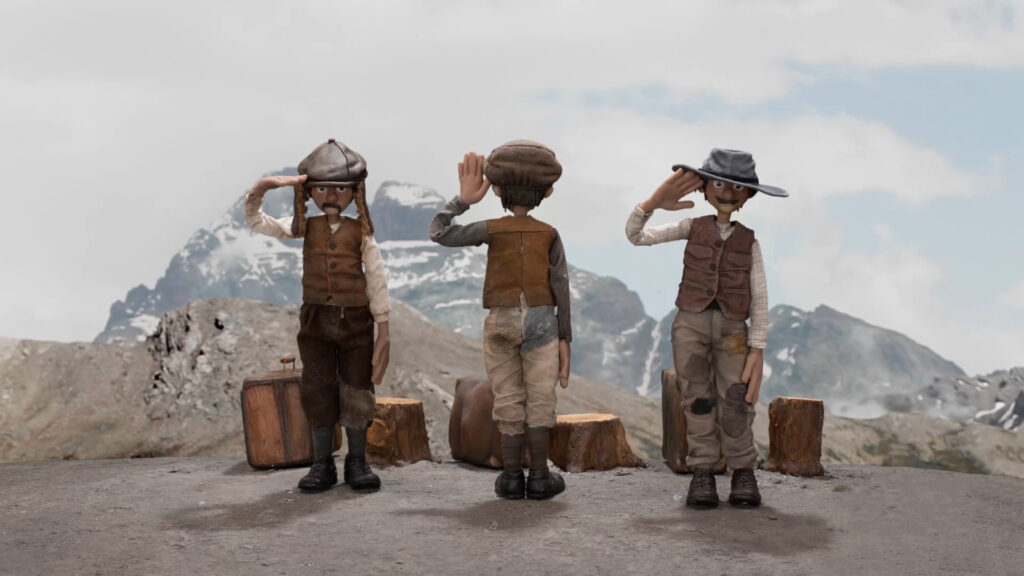
What Ughetto wanted to tell is not only the story of his origins, but also the story of all immigrants, wherever they come from in the world. A story of hard work, of adaptation, of gazes that lacerate the soul and leave irremediable wounds. This is why certain stereotypes in the film take on a different meaning, as if they were the images perceived by those who feel invaded and – not knowing other cultures and not understanding the languages spoken by migrants – judge those from other countries as inferior. As the original title makes clear: “forbidden to dogs and Italians”, a dramatic situation that our families have had to live with in the past and that is being played out again today, this time through the eyes of the viewer.
“MANODOPERA – INTERDIT AUX CHIENS ET AUX ITALIENS” DI ALAIN UGHETTO
I ricordi di un passato lontano che progressivamente svanisce nel tempo rimangono spesso legati a un mondo ideale rielaborato dalla nostra mente per preservare emozioni, sensazioni, fugaci istanti della nostra esistenza in cui abbiamo, anche solo per un istante, assaporato sprazzi di vera felicità. Manodopera racconta il mondo rievocato dalle dolci e nostalgiche parole di una nonna, restituendo la memoria di un’epoca passata, costituita tra sacrifici e spensieratezza, sofferenza e amore.
Il luogo, ricreato in stop motion, è un piccolo paesino di montagna situato ai piedi del Monviso che prende il nome di Borgata Ughettera e richiama le origini piemontesi del regista Alain Ughetto. Il film prende vita attraverso le parole di Cesira, sua nonna, che ripensa alla sua gioventù verso la fine del diciannovesimo secolo. Partendo da alcuni fondamentali avvenimenti, dà così origine a una realtà sospesa nel tempo che la fragile malleabilità della plastilina con la quale sono realizzati i personaggi enfatizza.
Tra case di cartone e bizzarri alberi di broccoli, gli oggetti utilizzati rappresentano in qualche modo un aspetto indispensabile per la storia; elementi tangibili, il cui scopo è quello di avvicinare la dolcezza di un ricordo alla purezza della natura. La semplicità del povero mondo contadino, l’incontro con il futuro marito Luigi, i difficili periodi di guerra e la necessità di emigrare in Francia per poter lavorare e sopravvivere: sono gli episodi che caratterizzano il passato di Cesira e che lei stessa descrive al nipote, in un surreale e poetico scambio tra l’universo animato e la presenza reale del regista sulla scena.

Ciò che Ughetto voleva raccontare non è soltanto la storia delle sue origini, ma anche quella di tutti gli immigrati, da qualsiasi parte del mondo essi provengano. Una storia fatta di fatica, di adattamento, di sguardi che lacerano l’anima e lasciano ferite insanabili. Per questo, alcuni stereotipi presenti nel film assumono un significato diverso, come se fossero le immagini percepite da chi si sente invaso e – non conoscendo le altre culture e non capendo le lingue parlate dai migranti – giudica inferiore chi viene da altri paesi. Come il titolo originale ben evidenzia: “vietato ai cani e agli italiani”, una situazione drammatica in cui in passato le nostre famiglie hanno dovuto convivere e che oggigiorno si ripropone nuovamente, rendendoci stavolta partecipi attraverso gli occhi di chi osserva.
Emidio Sciamanna
“VENUS” BY JAUME BALAGUERÓ
Article by: Emidio Sciamanna
Translated by: Noemi Zoppellaro
According to Mesopotamian mythology, the female demon Lamashtu was a devilish creature bringer of nightmares and diseases, who haunted unborn children by brutally ripping them out of their mother’s womb to feed on their blood. Venus, the latest feature by Jaume Balagueró, begins with a terrifying apocalyptic premonition: the reincarnation of the demonic figure is imminent and her coming will bring chaos and pain throughout the planet.
At the centre of the narrative is young Lucía, a dancer in an infamous nightclub run by a group of comically stereotyped criminals. One night, after stealing a big drug shipment from the gangsters, she miraculously manages to find shelter at her sister Rocío’s house, located in a building called Venus, in the decaying outskirts of Madrid. Venus – hence the title of the film – is a gloomy and mysterious place, home to dark presences that have been haunting the unfortunate residents for decades.
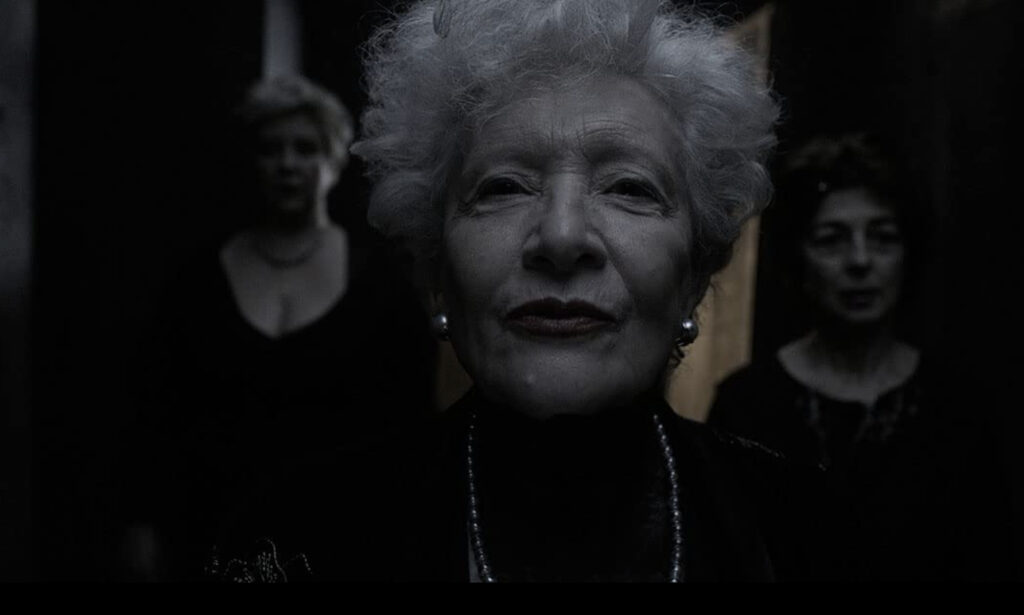
Loosely based on H. P. Lovecraft’s short story The Dreams in the Witch House, skilfully reworked by the Spanish director into a “horror story” with strong authorial connotations, Venus recalls in its structure the previous film, Muse, in which the paranormal subtly hovers against the background of an ordinary criminal investigation. Also in this case, the film crawls sinuously through the meanders of genre cinema, combining effectively sci-fi horror with gangster film, without ever becoming trivial or repetitive. Moreover, the caricatural element is intentionally emphasised, continuing the specific project on the grotesque that characterises the entire work of Balagueró.
This is definitely not the Spanish director’s masterpiece, however his ability to direct female figures is confirmed as excellent. In Venus, clearly inspired by Dario Argento’s characters, Lucía moves in a suffocating atmosphere, halfway between the nightmares caused by the demon and the oppressive reality of the daily life that the young woman must constantly face. For her, the building takes on a clear, although paradoxical, ambivalence: it is a prison that holds back her desire to dance, restricting her in a forced immobility caused by fear; but it is also a safe haven, a solid shelter to escape the demons that await her outside, the true nightmare of real life.
“VENUS” DI JAUME BALAGUERÓ
Secondo la mitologia mesopotamica, il demone femminile Lamashtu era una creatura diabolica portatrice di incubi e malattie, che prediligeva perseguitare i nascituri strappandoli con prepotenza dal ventre materno per nutrirsi del loro sangue. Venus, l’ultimo lungometraggio di Jaume Balagueró, inizia con un’agghiacciante premonizione apocalittica: la reincarnazione della figura demoniaca è ormai imminente e il suo avvento porterà caos e dolore in tutto il pianeta.
Al centro della narrazione troviamo la giovane Lucía, ballerina di un malfamato night club gestito da un gruppo di criminali comicamente stereotipati. Una notte, dopo aver rubato ai malavitosi un importante carico di droga, riesce miracolosamente a trovare riparo a casa della sorella Rocío, situata in un edificio denominato Venus nella decadente periferia di Madrid. Venus – da cui il titolo del film – è un luogo lugubre e misterioso, dimora di oscure presenze che da decenni affliggono i malcapitati inquilini del luogo.

Liberamente tratto dal racconto di H. P. Lovecraft, I sogni nella casa stregata, che il regista spagnolo rielabora abilmente in una “horror story” dai forti connotati autoriali, Venus ricorda per struttura il film precedente, La Settima Musa, in cui il paranormale aleggiava impercettibile sullo sfondo di una comune indagine investigativa. Anche in questo caso il film serpeggia sinuosamente tra i meandri del cinema di genere, amalgamando con efficacia l’horror fantascientifico e il gangster movie, senza mai risultare banale o ripetitivo. La componente caricaturale, inoltre, è consapevolmente enfatizzata continuando quel particolare lavoro sul grottesco che contraddistingue tutta l’opera di Balagueró.
Non si tratta certamente del lavoro migliore del regista spagnolo, eppure la sua capacità di dirigere le figure femminili si conferma eccellente. Caratterizzata da un’evidente ispirazione argentiana, la Lucía di Venus si muove in un’atmosfera soffocante, a metà tra gli incubi provocati dal demone e l’opprimente realtà della vita quotidiana che la giovane deve costantemente affrontare. Per lei l’edificio assume una chiara, seppur paradossale, ambivalenza: è una prigione, che limita la sua voglia di ballare imponendole una staticità obbligatoria attraverso la paura; ma è anche una zona sicura, un solido riparo per sfuggire ai demoni che l’attendono all’esterno, pronti a sfruttarla e gettarla via come spazzatura. Nonostante la presenza incombente di creature sovrannaturali e catastrofi cosmiche, per gli oppressi è dunque la società stessa a rappresentare la minaccia più terrificante, il vero incubo della vita reale.
Emidio Sciamanna
“NAGISA” BY KOGAHARA TAKESHI
Article by: Emidio Sciamanna
Translated by: Cora Bruno
Nagisa, a debut feature film by Japanese director Kogahara Takeshi, can be interpreted as a complex and layered attempt to reframe a bond, to redefine that thin filament that connects the body of those who survive and the increasingly evanescent memory of those who are no longer with us. The world that is portrayed is thus the result of a blurred mental condition, a set of indistinct reenactments created by the mind of a boy detached from reality.
Read all: “NAGISA” BY KOGAHARA TAKESHIThe protagonist is Fuminao, a Tokyo boy tormented by guilt over the death of his younger sister Nagisa, who died three years earlier in a bus accident on her way to visit her brother. One night, the boy accompanies his friend Yuki to visit a tunnel that, according to some popular beliefs, appears to be haunted by ghosts. In this mysterious and gloomy place, he will again face his past, his origins, until he relives in his mind the intense relationship with his missing sister. The film is basically a reprise of a homonymous short film by Kogahara himself in 2017, in which the two main characters, again Fuminao and Nagisa, are two young people in love. The adolescent “love story” of the former is thus contrasted, in this second work, with the memory of a deceased person and the reminder of the faint sigh of death, in a mad dance involving Eros and Thanatos until they become part of the same being.
The protagonist’s apathy, as well as the alienation that affects his existence, arise from the strong trauma triggered by the loss of a loved one. For this reason, the young man’s life is constantly punctuated by mechanical movements and continuous silences, depicted through the use of repeated and interminable fixed shots. The story is fragmented, not at all linear, as if every shred of memory spontaneously resurfaces when Fuminao savors certain physical or emotional sensations. This makes the film a real labyrinth with no way out, a puzzle in which, at times, it is difficult to understand the meaning of certain events.
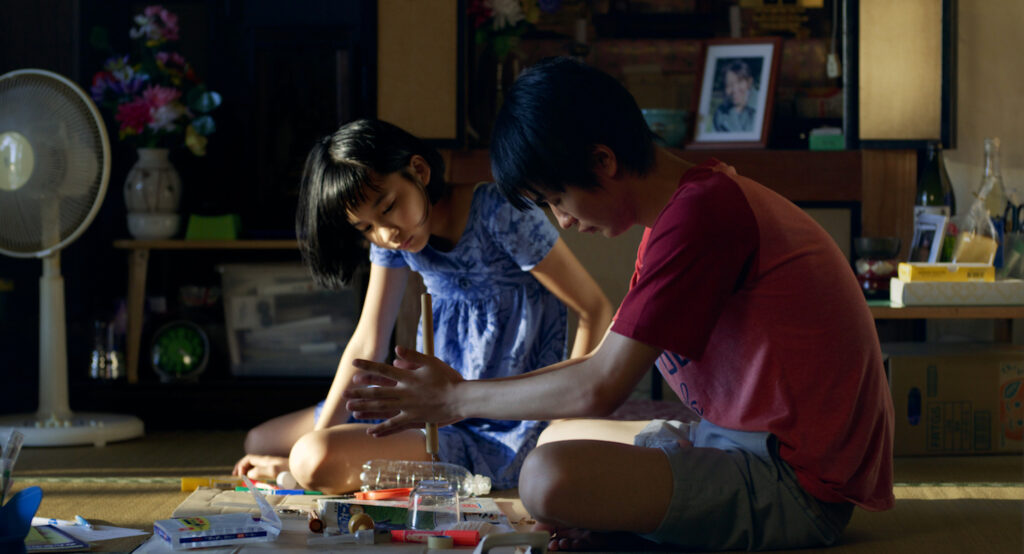
At the end of this enigmatic existential journey, there are many questions that arise, raising more doubts than answers in the protagonist’s mind. “Do ghosts really exist?” the boy hesitantly asks a policeman he meets by chance outside the tunnel. The man’s answer will come only after a long and ostentatious silence: “The ghost is you.” It is those who have remained anchored in the past, unable to continue a normal life, like a woman wandering the streets in search of her missing son, who represent the real ghosts of society.
“NAGISA” DI KOGAHARA TAKESHI
Nagisa, lungometraggio d’esordio del regista giapponese Kogahara Takeshi, può essere interpretato come un complesso e stratificato tentativo di rielaborare un legame, di ridefinire quel sottile filamento che collega il corpo di chi sopravvive e il ricordo, sempre più evanescente, di chi non c’è più. Il mondo che viene rappresentato è dunque frutto di un’offuscata condizione mentale, un insieme di indistinte rievocazioni partorite dalla mente di un ragazzo distaccato dalla realtà.
Leggi tutto: “NAGISA” DI KOGAHARA TAKESHIIl protagonista è Fuminao, un ragazzo di Tokyo tormentato dal senso di colpa per la morte della sorella minore Nagisa, deceduta tre anni prima in un incidente stradale mentre andava a trovare il fratello in autobus. Una notte il ragazzo accompagna l’amico Yuki a visitare un tunnel che, secondo alcune credenze popolari, pare essere infestato dai fantasmi. In questo misterioso e tetro luogo si troverà ad affrontare nuovamente il suo passato, le sue origini, fino a rivivere nella propria mente l’intenso rapporto con la sorella scomparsa. Il film è in fondo la riproposizione di un cortometraggio omonimo realizzato dallo stesso Kogahara nel 2017, in cui i due protagonisti, sempre Fuminao e Nagisa, sono però due giovani innamorati. Alla “love story” adolescenziale del primo si contrappone quindi, in questa seconda opera, il ricordo di un defunto e il richiamo al flebile sospiro della morte, in una folle danza che coinvolge Eros e Thanatos fino a renderli parte di uno stesso essere.
L’apatia del protagonista, così come l’alienazione che ne condiziona l’esistenza, nascono dal forte trauma scaturito dalla perdita di una persona amata. Per questo motivo la vita del giovane è costantemente scandita da movimenti meccanici e continui silenzi, raffigurati attraverso l’utilizzo di reiterate e interminabili inquadrature fisse. La storia è frammentata, per nulla lineare, come se ogni brandello di memoria riaffiorasse spontaneamente quando Fuminao assapora determinate sensazioni fisiche o emotive. Questo rende il film un vero e proprio labirinto senza vie d’uscita, un rompicapo in cui, talvolta, risulta difficile comprendere il senso di alcuni avvenimenti.

Al termine di questo enigmatico viaggio esistenziale sono molte le domande che sorgono, suscitando nella mente del protagonista più dubbi che risposte. «I fantasmi esistono davvero?» chiede esitante il ragazzo a un poliziotto incontrato casualmente fuori dal tunnel. La risposta dell’uomo arriverà solo dopo un lungo e ostentato silenzio: «Il fantasma sei tu». Sono coloro che sono rimasti ancorati al passato, incapaci di proseguire una vita normale, come una donna che vaga per strada alla ricerca del figlio scomparso, a rappresentare i veri spettri della società.
Emidio Sciamanna
“GROSSE FREIHEIT” BY SEBASTIAN MEISE
Article by Giulia Seccia
Translated by Elena Soldà
A match that lights up in complete darkness. This is the symbol on which Grosse Freiheit / Great Freedom, a film directed by Sebastian Meise in competition at the Torino Film Festival stands. It won the Jury Prize in the Un Certain Regard section in Cannes, and it will be presented by Austria as an Oscar candidate 2022.
Continua la lettura di “GROSSE FREIHEIT” BY SEBASTIAN MEISE“GROSSE FREIHEIT” DI SEBASTIAN MEISE
Un fiammifero che si accende nella completa oscurità. Questo è il simbolo su cui si regge Grosse Freiheit / Great Freedom, film diretto da Sebastian Meise in concorso al Torino Film Festival, che a Cannes ha vinto il Premio della Giuria nella sezione Un Certain Regard, e che verrà presentato dall’Austria come candidato agli Oscar 2022. Sguardi mantenuti nel tempo e tocchi evidenziati da inquadrature ravvicinate scandiscono il film del regista austriaco, insieme a sentimenti espressi tramite passaggi di sigarette, messaggi nascosti nelle pagine forellate di una Bibbia e parole taciute.
Continua la lettura di “GROSSE FREIHEIT” DI SEBASTIAN MEISE“THE DAY IS OVER” BY QI RUI
Article by Laura Anania
Translated by Stefania Frassetto
On his cinematographic debut, Qi Rui proposes in the Contest section Torino 39 the touching story of Zhang Jixiang (Li Yingchun), a twelve-year-old girl running from an oppressive and suffocating world. The main character lives in an extremely poor little town in the Chinese mountains, when, one day, she becomes her classmates’ target as she is falsely accused of stealing.
Continua la lettura di “THE DAY IS OVER” BY QI RUI“EL PLANETA” DI AMALIA ULMAN
L’artista multidisciplinare Amalia Ulman debutta in concorso al TTF 39 con il suo primo lungometraggio El planeta, già presentato al Sundance Festival del 2021. Il micro-budget e una piccola troupe composta da cinque persone rendono questo esordio un esperimento che rievoca il cinema indipendente statunitense degli anni ’90.
Continua la lettura di “EL PLANETA” DI AMALIA ULMAN

